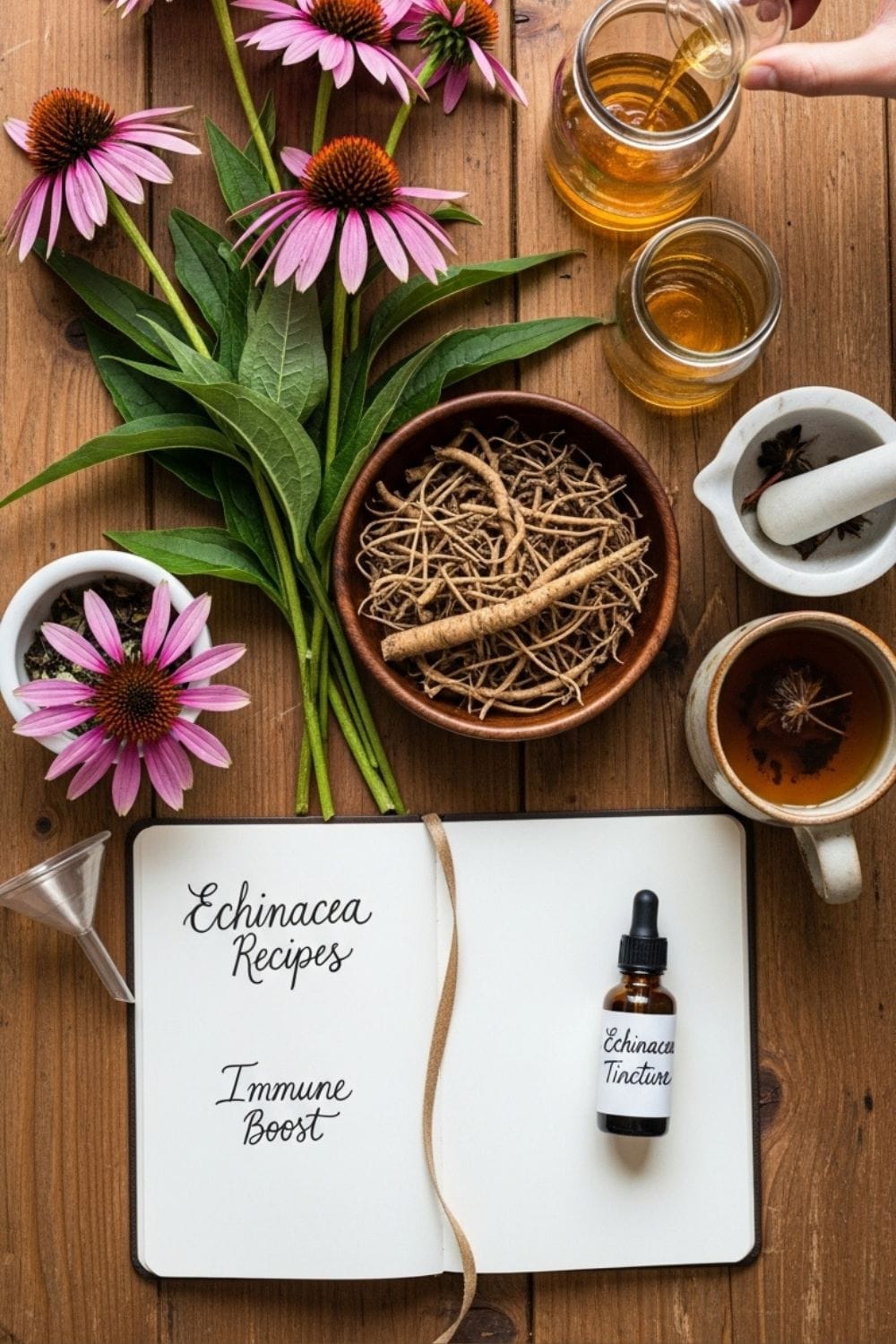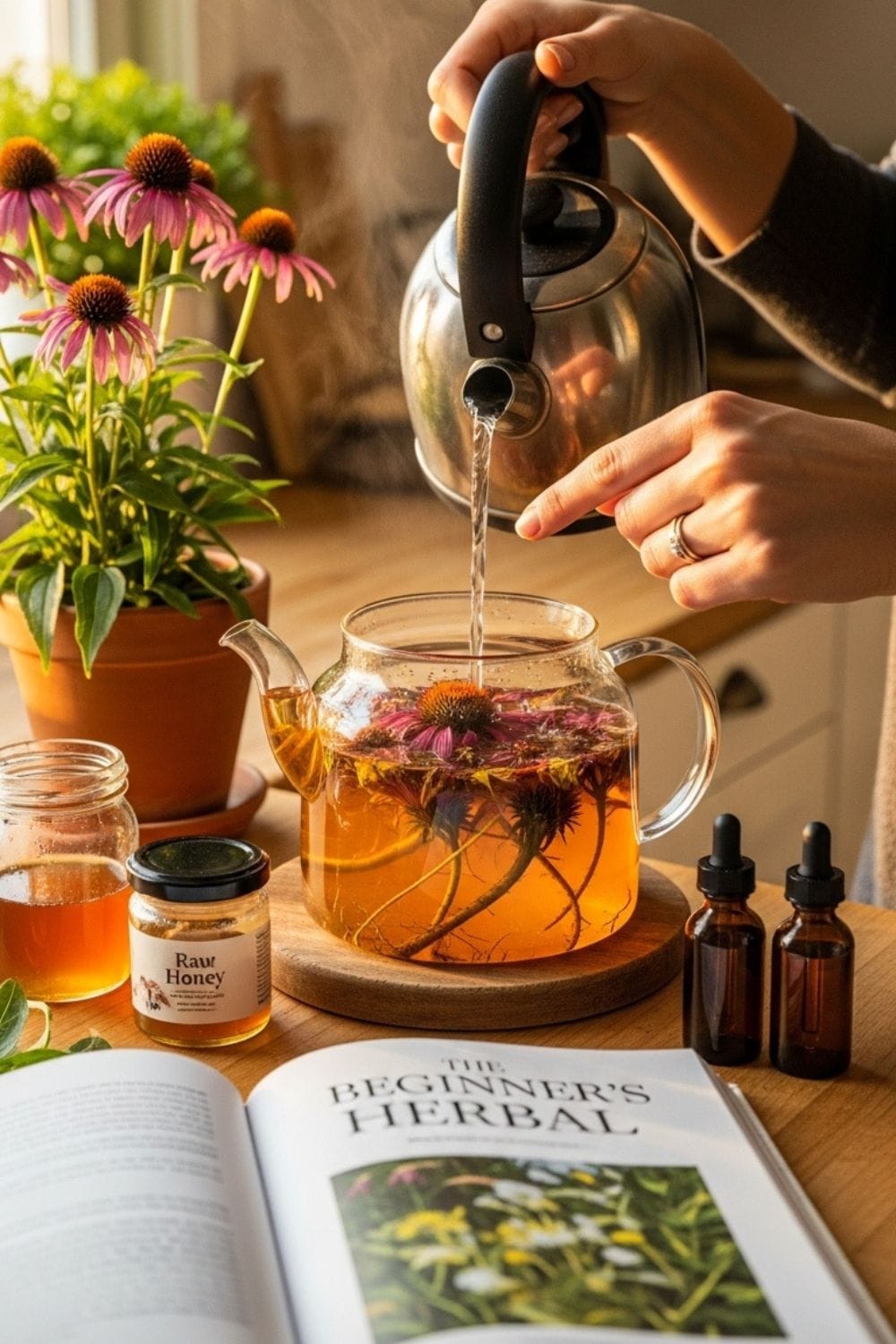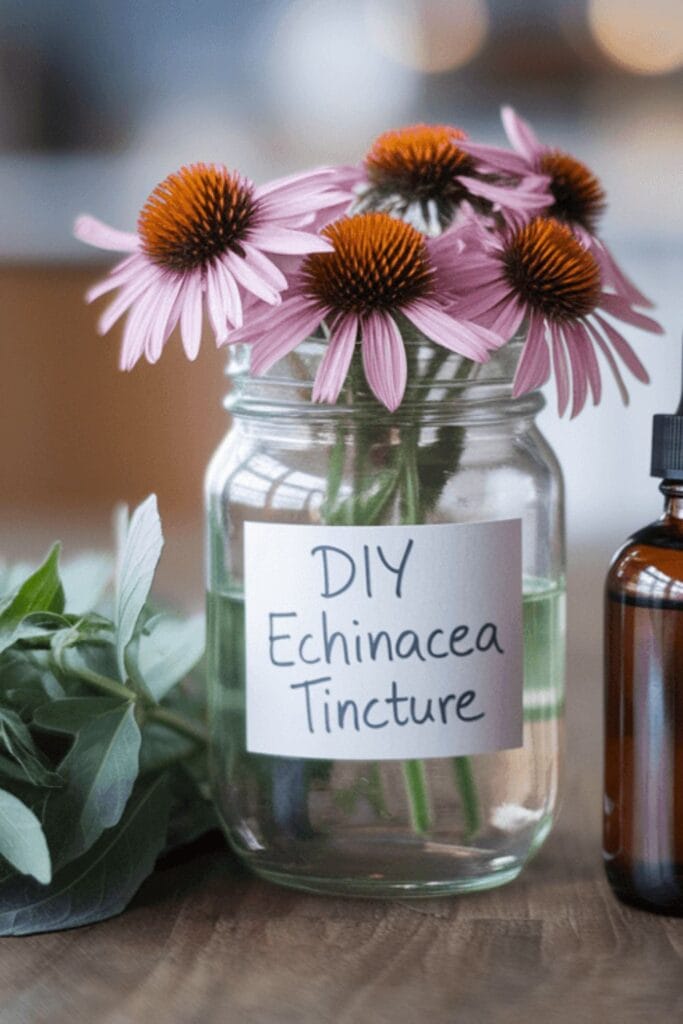Echinacea DIY remedies for beginners are the best way to harness the immune-boosting power of the purple coneflower, allowing you to create simple, effective home medicines to help your body prepare for cold and flu season. This herb may boost immune cell activity, helping your body respond more effectively to seasonal challenges.
Echinacea Benefits: The Science Behind Immune Support
Echinacea, also known as purple coneflower, has been a traditional North American immune ally for centuries. It works differently than typical vitamins; it doesn’t just replenish a nutrient, it may help modulate and stimulate your immune system.

How Does Echinacea Support Your Immune Health?
Research suggests that echinacea contains beneficial compounds like alkamides and polysaccharides that interact directly with the immune system.
- Stimulates Immune Cells: Echinacea may encourage the production and activity of white blood cells and macrophages (the body’s natural defense cells).
- Reduces Cold Duration: Studies suggest that taking echinacea at the first sign of symptoms may help lessen the severity and duration of seasonal illnesses.
- The Echinacea Zing: If you taste a potent echinacea product, you’ll experience a numbing, tingly sensation on the throat and tongue, known as the “Echinacea Zing.” This acrid, dispersive taste is a sign that the beneficial compounds are active and potent.
Echinacea’s Underrated Uses: Skin and Tissue Support
Echinacea is powerful for more than just colds. Its stimulating and cleansing properties (known as an alterative action) make it ideal for fighting localized challenges:
- Bacterial Infections: Herbalists use echinacea both internally and externally for skin abscesses, recurring boils, and acne. Studies suggest it can inhibit the growth of bacteria and reduce inflammation.
- Mouth and Throat Issues: Long known as the “toothache plant,” a diluted echinacea tincture can be swished in the mouth to address tooth infections or ulcerations of the mucous membranes.
Echinacea Tea vs. Capsules for Immunity: Which is Best?
The best way to take echinacea depends on your immediate goal: acute relief or daily convenience.
| Preparation Type | Pros | Cons | Best For… |
| Tea (Infusion) | Warm, soothing, hydrating. Provides immediate throat coating relief. | Less concentrated dose than tincture/capsules. | Acute onset of cold symptoms and throat soothing. |
| Capsules/Tablets | Consistent, concentrated dose. Quick and convenient for daily use or travel. | Bypass the soothing throat benefits of warm tea. | Daily preventative support and consistent dosing. |
| Tincture | Highly potent, fast absorption under the tongue. Long shelf life. | Alcohol content may be unsuitable for some. | Quick, focused action at the first sign of illness. |
How to Make a Simple Echinacea Tea Recipe for Colds and Flu Relief

A warm cup of echinacea tea is one of the gentlest remedies for supporting immune health and easing congestion.
| Ingredients | Quantity | Instructions |
| Dried Echinacea (Root, Flower, or Leaf) | 2–3 tsp | Place herb in infuser. |
| Water (Filtered) | 8 oz | Bring to just below boiling, around 185°F. |
| Optional: Honey/Ginger | To Taste | Steep covered for 10–15 minutes. Add honey to soothe the throat. |
Maximizing Benefits: The Echinacea and Goldenseal Duo
One of the most popular combinations is Echinacea and Goldenseal. This duo is often trusted for flu season because they work synergistically:
- Echinacea: Modulates and strengthens the immune response.
- Goldenseal: Contains berberine, which offers complementary soothing and cleansing properties for irritated mucous membranes in the respiratory and digestive tracts.
We recommend the Nutrition Restore 10-In-1 Echinacea Goldenseal Complex for a comprehensive blend designed for seasonal support.
Beginner Friendly Echinacea Remedies: Tincture Recipes

Tinctures offer the most potent and fastest absorption of the herb’s compounds. They are a staple of any home herbal pharmacy.
How to Make Echinacea Tincture at Home Step-by-Step (Alcohol Method)
This recipe is based on the professional 1:5 ratio (1 part herb to 5 parts liquid).
| Ingredients | Ratio (1:5) | Notes |
| Finely Cut and Dried Echinacea Root | 75 grams | Use roots for the highest potency. |
| 50% or 100-Proof Vodka/Brandy | 375 ml | This alcohol percentage is ideal for extracting all beneficial compounds. |
Instructions:
- Combine: Place the dried root in a clean pint jar. Pour the alcohol over the roots. If the roots absorb the liquid and become exposed, add just enough alcohol to keep them covered.
- Steep: Tightly seal the jar and label it with the date and contents. Store in a cool, dark place for 6 weeks.
- Shake: Shake the jar daily for the first week, then every few days after that.
- Strain: Strain the mixture through a fine-mesh strainer lined with cheesecloth, squeezing the solids well.
- Bottle: Pour into clean, dark glass dropper bottles. Store in a cool place and use within two years.
Alcohol-Free Option: Glycerite
For children, those avoiding alcohol, or a sweeter taste, use vegetable glycerine instead of alcohol. Follow the same steeping process, using a ratio of 3 parts glycerin to 1 part water.
How to Safely Dose Homemade Echinacea Tincture and Tea
Best Echinacea Dosage for Immune Health in Adults
For acute cold/flu symptoms (at the first sign of illness):
- Tincture (1:5 Ratio): Take 30–60 drops (1–2 mL) every hour or every two hours. Eclectic herbalists historically used frequent, small doses for best effect, rather than large doses 3 times a day.
- Tea: Drink a freshly steeped cup every 2–3 hours.
Important Dosing Note: Echinacea is energetically cooling and drying, making it specific for signs of heat and infection. Use it when symptoms are present.
Echinacea Side Effects and Who Should Not Take It
Echinacea has a great safety profile, but it’s essential to use it mindfully.
Can I Take Echinacea Daily for Immune Support?
It is generally recommended to use echinacea for short periods (at the onset of symptoms or cyclically for 8–12 weeks). While the common belief that you must stop taking it is based on a misinterpretation, continuous use may dull the body’s response. Cycling on and off is the safest approach to maintain its effectiveness.
Who Should Avoid Echinacea?
Echinacea is an immune stimulant. It is safest to avoid it or consult an herbalist/doctor if you have:
- Autoimmune Conditions: (e.g., Lupus, MS, Rheumatoid Arthritis) Because echinacea stimulates the immune system, it may conflict with medications or exacerbate conditions where the immune system is already overactive.
- Allergies: Individuals allergic to the daisy family (ragweed, marigolds) may be sensitive to echinacea.
- Immunosuppressant Drugs: Do not take echinacea if you are on medications to suppress the immune system.
Trust & Safety: Due to the potential for medication interaction or conflict with existing conditions, anyone who is pregnant, breastfeeding, or managing a medical condition should speak with a healthcare professional before starting this or any new herbal regimen.
Echinacea DIY Remedies for Beginners: FAQ Section
The tincture (alcohol-based) is generally more potent and faster-acting, as alcohol can extract more compounds than water. However, the tea offers better soothing relief for a sore throat or dry cough.
Echinacea purpurea is the easiest to grow and is excellent for making remedies from the whole plant. E. angustifolia is often considered the most potent but is harder to grow and typically only the root is used. To understand the difference in root systems and growth habits, read our guide on Growing Echinacea from Seed.
Growing your own ensures freshness and potency! You can find high-quality seeds for the best beginner variety (E. purpurea) in the Medicinal Garden Kit.
Yes. Eclectic physicians used echinacea for infected wounds, spider bites, and stings. You can apply a diluted tincture (mixed with water) directly to the area, supplementing with internal doses.
Echinacea pairs beautifully with soothing demulcent herbs like Marshmallow Root for throat relief. You can learn how to make a complete, coating infusion in our guide on Marshmallow Root for Sore Throat.